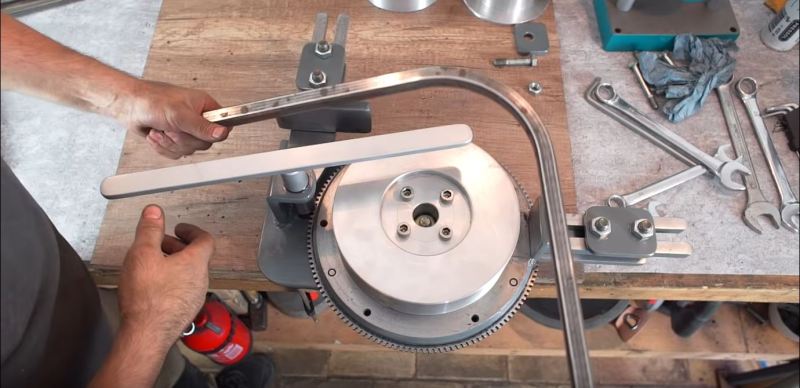The ability to look at a pile of trash, and see the for treasure is a skill we hold in high regard around here. [Meanwhile in the Garage] apparently has this skill in spades and built himself a metal bar bending machine using an old flywheel and starter pinion gear.
To bend metal using muscle power alone requires some sort of mechanical advantage. Usually this involves a bending tool with a long lever, but [Meanwhile in the Garage] decided to make use of the large gear ratio between a car’s starter motor and the flywheel it drives. This does away with the need for a long lever and allows bending to almost 270° with a larger radius. Lathe and milling work features quite prominently, including to make the bend formers, drive shaft and bushings and to modify the flywheel to include a clamp. The belt sander that is used to finish a number of the parts is also his creation. While the machine tools definitely helped, a large amount of creativity and thinking outside the box made this project possible and worth the watch.
We’ve featured a number of scrap-built tools including a milling machine, sheet metal hole punch and a hydraulic bench vice. Keep them coming!
















Neat timing, project and article! Had a new answer yesterday regarding pulling these off with other answers relating to other types of pulleys also here: https://www.quora.com/How-do-you-get-the-engine-pulley-off-the-engine-shaft-if-its-seized-without-damaging-anything
I’ll keep this in mind next time out in the yard.
Real easy to turn a pile of trash into something when you have a lathe
It’s easy to make stuff if you have skills and ability…what’s this? You don’t even have a lathe in your shop?
Despite needing a lathe, it’s still a very interesting approach, and an interesting re-use of existing components.
I’d love to see a design for something that allows for non-uniform curves to be bent – e.g.: half an ellipse. The best way I can think of doing something like that is to use a ring roller, but mark the spots along the piece being bent where you need to start/stop. The frequency of the marks would increase as you get toward the end of the piece, giving it more of a curve.
A lathe helps but this can be made from existing parts with a drill and grinder if you take your time. The planetary out of any fwd trans would make a great barring that can hold level to the bend axis. Brake rotors for inner radius. Rest cand be cut and bolted, welds are nice but not the only option.
Is there recommend software to create simple (roll bar) and not so simple (3 to 4 bends) bended frames?
Literally any of the mature CAD packages… You can either use Fusion360 or if you don’t share the enthusiasm for the cloud, Solidworks has student licenses that they give out to hobbyists, you just have to search for it and it lasts only 1 year.
Or you can go for the open source crowd.
Nice skills, takes up a lot less space too (compared to a swing arm or hydraulic press) – check out one of his other hacks :) [youtube https://www.youtube.com/watch?v=UoP92BYqpEw&w=560&h=315%5D
I love his idea and speed of execution- I hate the way he used his lathe with an angle grinder. Yes, it physically works- but even covered up, it takes one particle of grit from that to ruin the bearings, or score his bed after it gets stuck against his saddle.
Dude does not take care of his equipment. Soak that in naval jelly to get rust off, vinegar, sandblast, but don’t use a lathe for a grinding aide like that.
His idea is sweet otherwise, I really like it
I always like to see old brake rotors used in projects. Seen em used with bowling balls for a giant version of panavise for welding, flywheels for windmills, etc. After seeing this, “Could use a brake rotor maybe”
Erm, this is an engine flywheel…
He knows. See last sentence.
Funny thing is I thought exactly the same thing. Instead of lathing the forms (I haven’t watched the video, the pic is enough) why not use things you already have. Like a bunch of brake discs with differnet sized bells.
I was also thinking why not repurpose an old engine block too rather than making up a new plate and so on. Less portable but nice and sturdy. an I4 or I6 and make the holder off the top of the block where the head would normally be.
Starter bolts up easily too.
Engine block can also be used to make ghetto lathes.
Nicely made unit and the geared handle is great.
Not so great is the great pile of swarf on the floor and cleaing chips with compressed air is really bad shop practice.
Removing the rust from the flywheel can be easily done with the “poor man’s sandblaster”, a rotary wire cup/mop on the angle grinder. Readily available in sizes to fit most grinders, and cheap. Then that can be done on the bench or floor away from the lathe.
Bite my shiny metal a** – Bender
Isn’t there some way to prevent hollow tubes from crushing when bent like that? Fill the tube with sand? Fill it with water and freeze it? I don’t remember…
I like this idea. I’d like to see a power version, an easy way to do that may be to add another flywheel and starter gear below it for gear reduction and then spin the second starter gear with a drill.